If you’ve been onto the Brunel University London campus over the past few weeks, you may have noticed a few things out of the ordinary. From the cryptic poems displayed on the public announcement screen, to the fluttering windsocks proudly flying from the lecture centre, something, it seems, is afoot.
That something, it turns out, is Phil Coy, Brunel’s first ever artist-in-residence, who for the past year had been developing work commissioned by two of Brunel’s best-known figures, Prof Akram Khan, professor of experimental particle physics, and Prof Will Self, professor of modern thought, that give a sense of the university’s history and sense of place on the outskirts of London.
To celebrate the successful end of the residency, Brunel is running a public programme of Phil’s works which features a walking tour, a talk from the artist and an ‘in-conversation’ discussion with Prof Khan, where the two will have an opportunity to reflect on the broad and diverse range of pieces produced over the past year.
Before the public arrive however, we were given the exciting opportunity to get a personal tour of the works currently in place, and to quiz the man behind the art about his work…
Tickets are available for both the Friday (29/11) and Sunday’s (1/12) Public Programmes – click through for details.
For further information, please visit brunel.ac.uk/news-and-events/events/2019/Brunels-Artist-in-Residence-A-Public-Programme
Site Office [closed circuit meditation facility]
The first stop on our tour is Site Office [closed circuit meditation facility], located in a portacabin at the back of Brunel’s iconic Lecture Centre – a building made famous (or infamous) by Stanley Kubrick’s dystopian masterpiece A Clockwork Orange.
Inside we find a sweetly fragrant meditation space, where we settle down in front of 18 CCTV screens, each showing a different snapshot from somewhere on Brunel’s campus. A group of around 30 people – staff, students and members of the public – snake between the screens in an ongoing figure of eight, “like a serpent eating its own tail,” as Phil puts it. There’s no sound except the distance hustle and bustle of the campus outside the portacabin.
“I’ve worked with CCTV before, so it’s an ongoing fascination,” Phil tells us. “When I realised earlier in the year that it might be possible to work with Brunel’s CCTV system, it was an exciting prospect, because it’s not normally something you can do. The CCTV really allows us to see the University as a microcosm of society. It’s like we’re looking into a model, and I think that’s a valuable perspective to have – it’s a scale you can work with and try things out on.”
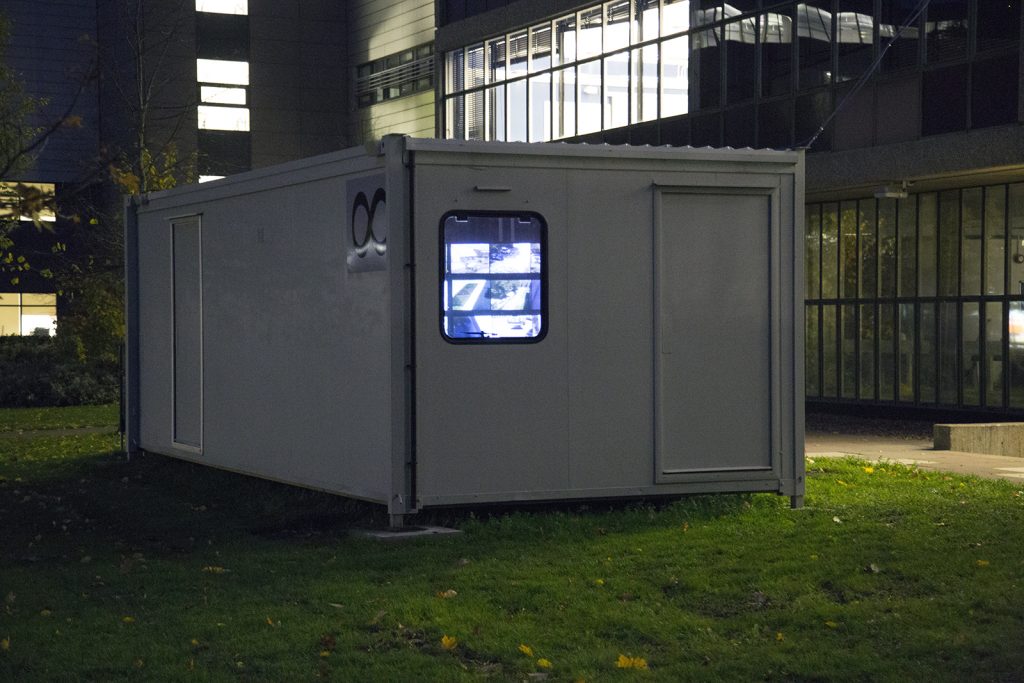
Site Office is located at the rear of the Lecture Centre
Sat on the floor looking up, there is certainly something that draws you in about Site Office. Beyond the looping line of people, you start to notice other little things going on around the site – a delivery van on its rounds here, a small group of chatting students there.
“One of the nicest things about it is the odd repetition of everyday actions,” says Phil, picking up on the observation. “Look, there’s someone crossing the road with their laundry.”
Phil wanted to present the work as a meditation space, rather than have it in a public area of the university, to help draw the audience in, and engage with its bigger themes, such as infinity, without it being ‘too pushy’. It’s a point Prof Akram Khan picks up on later, when we speak to him about the work.
“I love the infinity portacabin,” says Prof Khan, who spends much of his time working on the Large Hadron Collider in Switzerland, investigating sub-atomic particles.
“Phil and I had a big discussion about how it’s meditative and you lose yourself into it, if you are with it long enough. You lose yourself into it, almost floating and dissolving in this figure of eight.
“You begin to ask yourself exactly what it is you’re falling in to and about the patterns of life you fall into regularly.”
Eleven Windsocks for Brunel
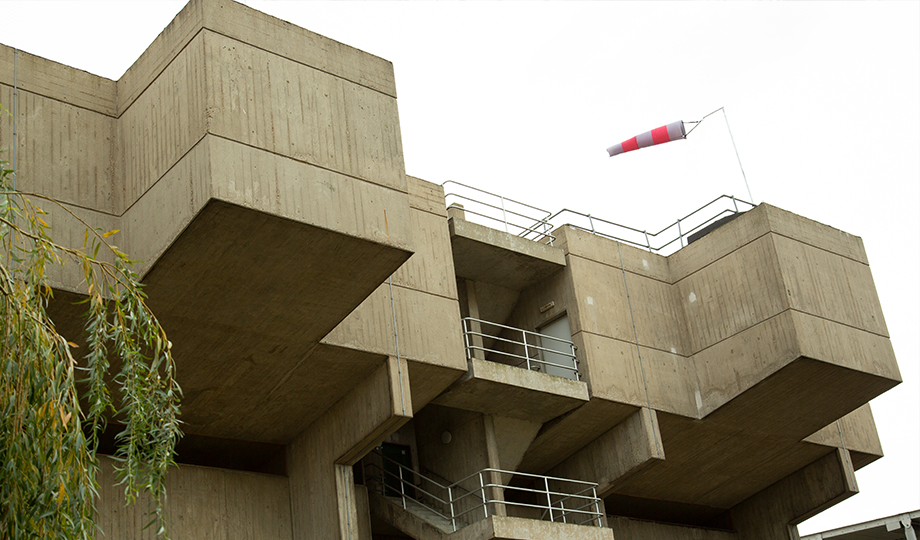
Linnet on Lecture Centre. The 11 windsocks each represent a different local bird species
Feeling relaxed from our time in Site Office, we set off around a blustery campus to see Phil’s next work, Eleven Windsocks for Brunel. Looking up to try and locate the socks – and looking up isn’t something we often do when walking around campus – we’re struck by how many birds of prey there are hovering above us, waiting for a suitable meal to present itself.
It’s either a fitting accident, or a stunning piece of prescience by Phil, but this instantly encapsulates part of the idea behind the socks, which examines not only Brunel’s place within a few miles of Heathrow – the world’s second busiest airport – but also its diverse local birdlife.
“I thought it could be interesting to work with windsocks but I didn’t want to make windsocks like you’d see at festivals,” Phil tells us as we position ourselves between the Howell Building and The Towers, where you get the best view. “It’s not un-significant that we’re just a few miles from Heathrow.
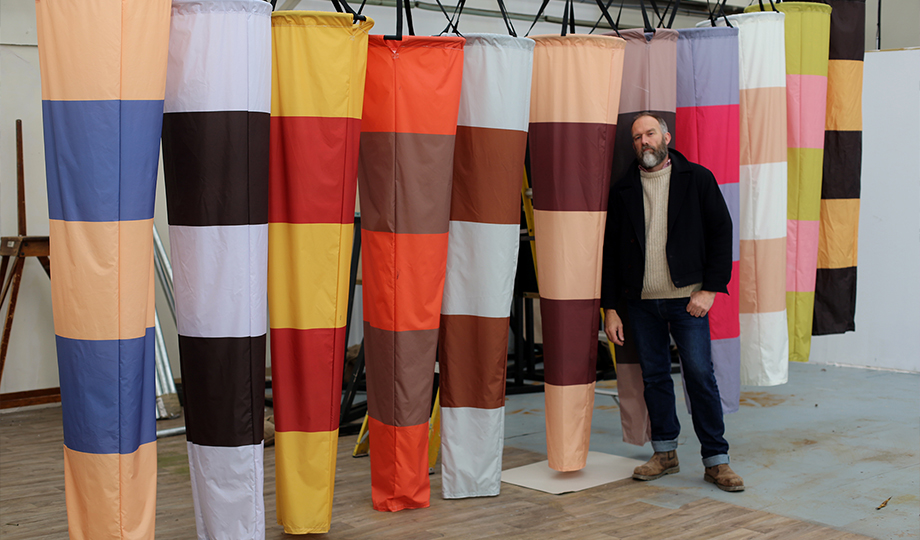
Phil Coy with the windsocks before they were placed around the Brunel campus
Each of the windsocks is based on the specifications of those you’d find at an airport, which signal to pilots and air-traffic controllers not only which way the wind is blowing, but also how strongly. “The difference here is that I’ve changed the standard design with new colour of stripes – there’s two colours on each, each representing the plumage of a different local bird,” says Phil.
The windsocks are Phil’s most visible piece and it’s likely many on campus will have already spotted the windsocks as they move around the campus, but without knowing what they’re for.
“That was partly Will Self’s desire,” Phil tells us when we mention that people have already been commenting on the windsocks.
“Will was quite emphatic that he wanted everyone to know I’ve been here. Which sounds like a simple thing to say, but making works that actuate that is quite a challenge – it’s great to see the windsocks highlight aspects of Brunel’s architecture, and naturally pair with buildings. I particularly like the almost accidental titles like Linnet on the Lecture Centre or Goldfinch on Antonin Artaud.”
The birds that each of the windsocks represent will be published in the freely-distributed imprint eleven windsocks for Brunel, which Phil conceived of alongside Prof Self as a reference to the classic Frederick Warne & Co book, Observers Guide to Birds.
You can pick up your copy of eleven windsocks for Brunel from Site Office and the main reception.
Highway Haiku
We make our way from the older, central part of the campus, where most of the windsocks are placed, toward the more modern end of campus where people enter along the road between the Eastern Gateway Building and Mary Seacole Building, to see Highway Haiku, a piece which uses the digital signage on the roundabout, more commonly used for updating staff and students on parking restrictions and survey deadlines.
“Similar to the windsocks, I liked the idea communicating with people using another utilitarian device, this one that we see by the side of the roads all the time but don’t necessarily think about,” says Phil, as we watch a simple poem repeat on screen.
Once More I Approach
Fearing Stagnated Delay
As If It Matters
Each of the Haikus was submitted by a member of staff or student, including one from Prof Self, following a call-out earlier in the year, and whilst not all of them will make it on to the screen, a collection will be published to accompany Phil’s public programme.
“It’s an amazing piece of technology for getting a message out there,” said Phil as the Haiku scrolls on a loop. “I thought it was a great opportunity to use that message for haikus which make people think about their journey to and from work, and what that might mean.”
There isn’t any point
In saying how I got through
The man-machine matrix
- Will Self
Stereo Pair
As we make our way back across campus to speak with Prof Khan about his thoughts on the collection, Phil talks us through three sculptures that will be installed in the John Crank Gardens next year as a permanent reminder of his time as Brunel’s artist-in-residence.
“They are a physical and material collage of three references,” says Phil, describing the three concrete structures, which will act like sound amplifiers for people sitting inside them.
“Because of our proximity to Heathrow and Northolt Airports I began thinking about the pre-radar listening devices, or sound mirrors, along the south coast of England that I’ve been fascinated by for years. We’re using concrete as a structure for listening, which is the first reference.
“Then there’s the HMV gramophone horn, which is a solid state amplifier but also a symbol many people recognise,” he says, referencing the famous HMV Morning Glory Gramophone (most commonly depicted with a small dog sat next to it,) which was produced locally.
“And the last reference is the Brutalist architecture Brunel is famous for, which will be reflected in the formwork we use to cast the sculptures.”
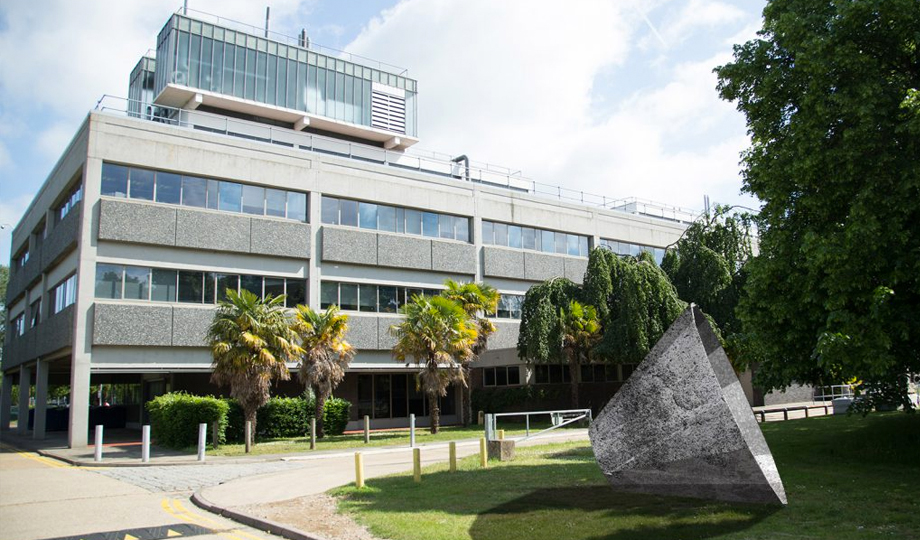
An artist's impression of Conical Forms, which will be placed in the John Crank Gardens next spring
The sculpture will incorporate some of the rubble retrieved from the John Crank Building, which was pulled down earlier in the year to make way from the university’s new Learning and Teaching Centre.
“I couldn’t ignore that building being pulled down – it’s a piece of Brutalist architecture being demolished in the place where A Clockwork Orange was shot. I think Kubrick’s film quickly shaped this country’s view of Brutalist architecture – and hammered the first nail in the coffin for that style. I have collected material for a new film ‘grey goo’ whilst at Brunel, that includes aspects of the demolition, and the John Crank atrium, that Kubrick used as a location for the film, so the work will continue beyond the scope of this residency.”
Final thoughts
We finish our tour at Prof Akram Khan’s office having seen all the works currently on display, and excited for the opportunity to see the others that haven’t yet been installed at the time of our tour – such as an audio installation, The cars hiss by my window like the waves down on the beach, which will be placed in the Antonin Artaud building.
“Will came up with this wonderful idea of ‘where are we?’” says Prof Khan, when we ask him what inspired a professor of particle physics and a professor of modern thought to commission an artist. “I think that’s a very profound question – there’s multiple layers as to what that means.”
An artist such as Phil Coy, he says, is what’s really needed to explore those multiple layers.
He concludes our tour: “What I do at the Large Hadron Collider is look at the unknown, to look at the invisible, at the subatomic level. You can’t see these things, but you make some sort of extrapolation to reality.
“What Phil’s done is give us a new set of lenses, a new set of ways of looking at something that’s familiar. It destabilises our sense of what we’re looking at and makes us reevaluate the familiar into the unfamiliar.”
Tickets are available for both the Friday and Sunday’s Public Programmes – click through for details.
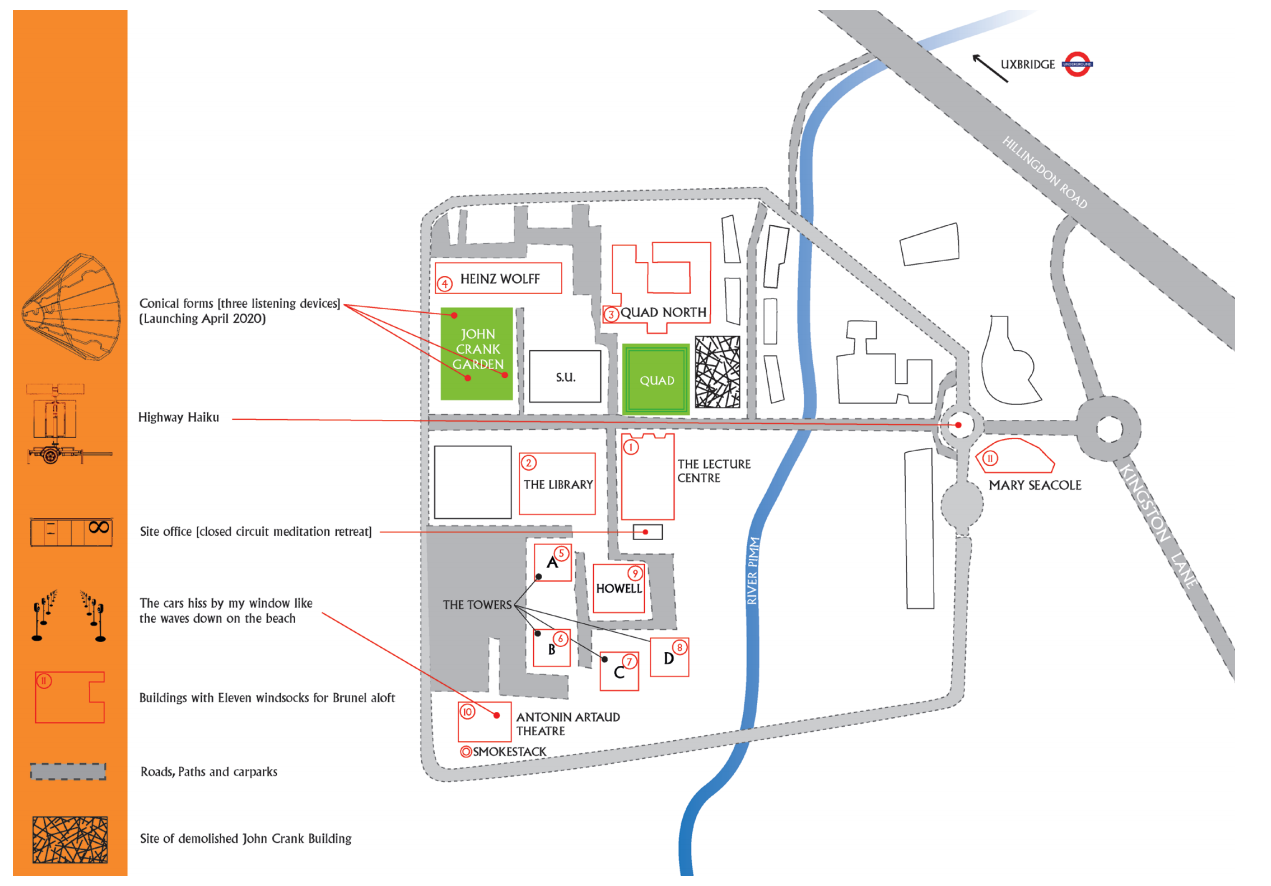
Where the pieces are located on campus
Reported by:
Tim Pilgrim,
Media Relations
+44 (0)1895 268965
tim.pilgrim@brunel.ac.uk